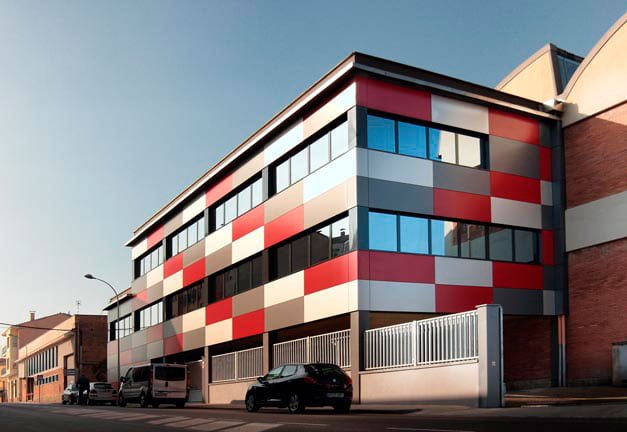| 6-TRANSFORMATION OF THE COMPOSITE PANEL |
|

The advanced manufacturing process of the composite panels allows an extraordinary adhesion between the different layers. Tests performed on all products at least duplicate the parameters recommended by various standards. Thanks to this perfect assembly between the different parts that make up the composite panel, it offers an extraordinary capacity for machining in all its variants. The following operations should be carried out at temperatures above 10ºC:
Cutting can be performed in: Vertical circular saws (straight cuts) ? CNC machining centers (straight and curved cuts) Shear ® (straight cuts): larson metals INOX |
Milling can be performed in: Portable disc milling machines Vertical manual milling machines with feelers CNC machining centers |
The panel can be bent without difficulty using three- or four-roll bending machines, making sure that the rolls are clean to avoid damage to the material.
a) Bending of 3 or 4mm thick larson panels. Bending dimensions: Maximum bending width: 4000mm (bending length). Minimum radius: 150mm.
b) Bending of Metals Inox panels Bending dimensions: Maximum bending width: 4000mm (bending length). Minimum radius=1000mm.
c) Bending of larson trays 4mm thick with edge Bending dimensions: Minimum bending width: 150mm. It corresponds to the width of the bushings; the separation between bushings will be the thickness of the panel, so that it will be through this separation that the edge will move at the time of bending. Maximum bending width: 4000mm (bending length). Maximum tray edge: 20mm.
NOTES: a) When bending with tray edge >20mm, the tray may become deformed and is not recommended. b) For bending, it is necessary to interpose a 2 mm thick aluminum plate, thus avoiding the marking of the edges of the Teflon bushings used. If this plate is not used, marks may be visible on the tray. c) When the bending radius is greater than 1000mm, it can be made flat, subsequently folding the flange. For this purpose, a smaller radius will be given, so that during folding the tray will go to the desired radius. In any case, in this type of bending, the flange is not perfectly flat, and undulations can be seen on the flange. d) INOX metals shall be made with 40 mm fins only in the bending direction. e) Due to the low stiffness of the 3mm composite panel, it CANNOT BE CURVED in a flanged tray, because of the deformation of the flange during bending. f) A previous study will have to be made to verify any type of bending desired by the client to ensure its correct execution. |
The panel must be protected both in the area in contact with the tool and in the area resting on the die to avoid damage. MILLING TYPES ? 90º folding with tools whose cutting angle achieves a perfect 90º fold. ? 90º folding<180º with tools whose cutting angle achieves a perfect folding to the angles indicated by the customer. To achieve the desired size, the bending should always be done in the milling axis as shown below.
|
Perforation in composite panels is a reality, the possibility of achieving previously unimaginable effects is now possible thanks to the different combinations of perforations.
Perforation is guaranteed on your larson panels due to their unique characteristics and performance. High-quality aluminum alloy 5005 ? Anti-corrosion pretreatment of your metals ? Exceptional metal to core adhesion (peeling) ? 10-year outdoor warranty (*) ? Perforated for facades – Double-sided lacquered panels ? Perforated for interior ceilings – Lacquered on one side ? Infinite types of perforation Both on CNC machining centers and punching machines, we offer the possibility of making an infinite number of perforations: circular perforations of different diameters, squares or rectangles of different sizes, colisos, rhombuses, stars, triangles… In addition to its use in facades, today perforated ceilings are a clear commitment to modernity in interior applications and suspended ceilings.
Taking into account the following nomenclature, Alucoil offers a wide range of punchings capable of giving each type of facade an exclusive design. R”: Round (diameter of the perforations). U”: Drilled in parallel (distance between axes). ? “T”: Drilled in staggered stagger (distance between axes). C”: Squares (side of square). ? “LC”: Rectangles (width x length). LR: Flats (width x length).
The perimeter strip without perforation will be indicated by the type of perforation and die used for each particular case. To combine different diameters within the same panel, perforations and special sizes, please consult possibilities. |
Our company offers different services and products related to the construction sector. Thanks to our variety we can offer different constructive resolutions to your most special needs.
131 Palauet Street
Catalunya – Lleida – 25001
Email: info@starmodul.com
Tel: +34 973 22 81 64
Mobile: +34 683 442 608

¿Necesitas ayuda?